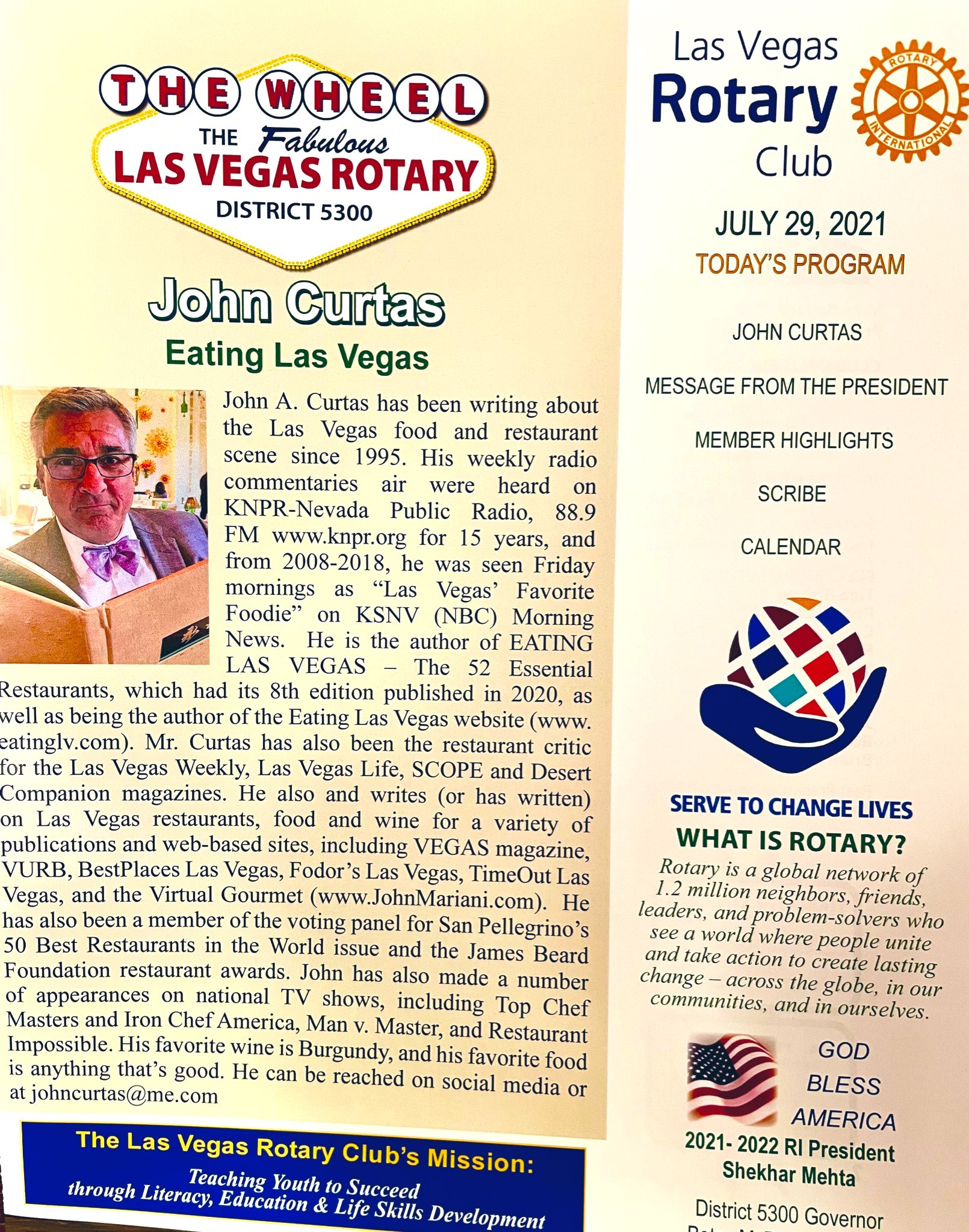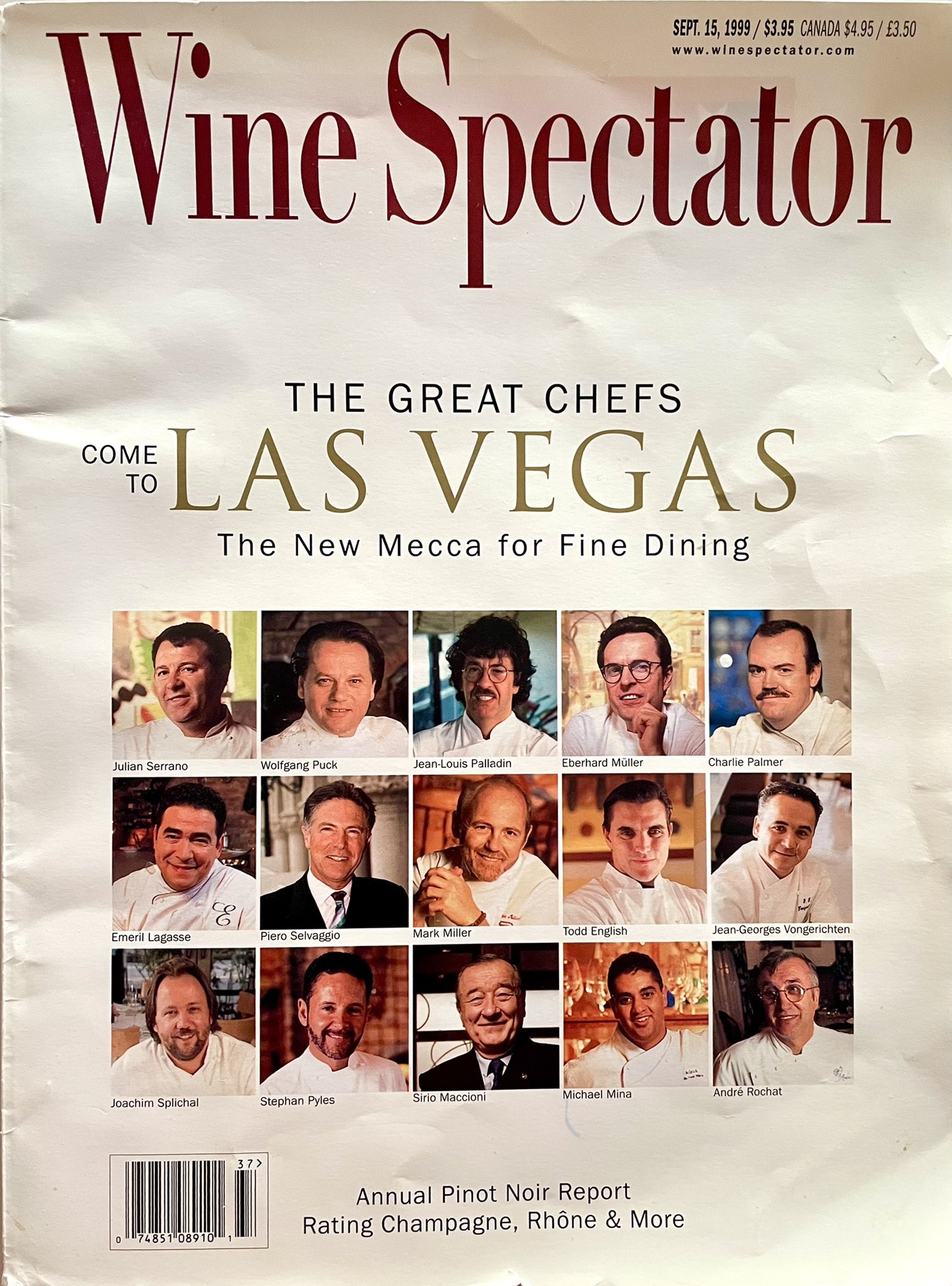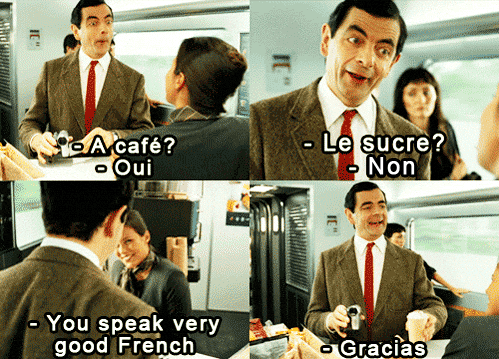Speaking in public is as natural to me as polishing off a Poulet de Bresse en Cocotte avec Champignons Glacée et Truffes with a bottle of Clavoillon Puligny-Montrachet 2018.
Between my legal career, trial work, teaching gigs and second career as a semi-famous food critic, I suppose I’ve addressed crowds (ranging from a handful to hundreds) at least a thousand times in my life.
In that last capacity, I get asked occasionally to give talks to local groups who want to hear about my career as that food dude who has spent most of his adult life obsessing over restaurants.
About a month ago, I gave such a speech to a nice group of local Rotarians. Wonderful people; nice lunch (at the always-lovely Lawry’s).
It was a version of the same talk I’ve given many times over the years, charting the culinary history of Las Vegas, my food-writing origins, and the state of our gastronomic state….all of it spiced with recommendations and tales of my many tangles with celebrity chefs.
I was sober, not hung over, and plenty prepared (not always the case years ago). But still, I rambled and forgot a few things, and it’s been bugging me ever since.
My wife (the long-suffering Food Gal®) was in attendance and gave my speech a “it was fine, you were great” review in the same tone she uses to cheer me up after another mediocre performance in bed.
So….I’ve decided to actually write out the same speech I’ve been giving for 25 years and condense my thoughts into a single 20 minute script.
There may never be a next time. Perhaps my speech-making days are over. (As I told the Rotarians: I’m a dinosaur and I know it. I was Las Vegas’s first real restaurant critic, and I’m probably destined to be its last.)
But if there is another one, if I am asked to give one more, I’ll be prepared, for once.

Intro
The three questions I get asked most often when someone hears I am a restaurant critic are: How did you become one? How many times a week do you eat out? And how do you stay so thin? (turn sideways) The answers are: It’s a long story; ten times a week; and I have the metabolism of a hummingbird.
As for my weight, well, to quote the late, great Los Angeles food critic Elmer Dills (remember him?): I’m not as fat as I could be nor as thin as I should be.
Being a restaurant critic is a lot like being a horse put out to stud: It sounds like a great idea until you have to do it on command, all the time.
Anyway, being a serious critic — one who writes for money about restaurants on a regular basis — you get a lot of dudes (it’s always guys) who’ll look at you and say, “I could do that; sounds like fun No big deal. I like to eat.” It’s the same shit they say when they meet male porn starts: “Damn dude, that ain’t work. Sign me up!” Well, like a porn star, you look at these fools and say, “No, dude, you can’t. You couldn’t keep up with me for three days.”
Of course, as with sex, the tasting is the fun part; the work is in making it fun for others. But more on that in a minute.
First, let’s talk about how Las Vegas went from “The Town That Taste Forgot” to Gourmet Capital to Celebrity Chef Hell…
So….how DID we go from the Town That Taste Forgot to one of the gastronomic capitals of the world? People like to say it started with Wolfgang Puck at Spago in the Forum Shops in December, 1992, but in reality, it began a few years earlier with a chain steakhouse….and that steakhouse was…
Ruth’s Chris! Yes, as the story goes, Ruth Ertel — the founder of Ruth’s Chris — loved to gamble in Vegas. Her favorite dealer at Caesars was a fellow named Marcel Taylor. Taylor was an ambitious sort, and sometime in the late 80s he persuaded Ertel (over the objections of her board of directors) to open an outlet in Las Vegas. The thinking then was: Why on earth would anyone ever leave a casino to eat? Every hotel in those times had four different eateries: a coffee shop, a buffet, a steakhouse, and a “gourmet room” serving “continental cuisine.” (From which continent they never really specified.)
Keeping the customer captured was on every hotels’ mind back then. The thought that people would leave to peruse the dining options at another hotel was ridiculous. The idea they might venture a mile off the Strip to eat was unthinkable.
But in 1989 Ruth’s Chris opened on Paradise Road and within a year it was the best performing venue in the chain. Other prime chain steakhouses took notice, and within a couple of years, Morton’s and Palm (back when both were actually good) had opened outposts here.
The next big moment came in 1994/1995 when Gamal Aziz (a forgotten name but pivotal in birthing Vegas’s gastronomic renaissance), brought Emeril Lagasse, Charlie Trotter, and the Coyote Cafe’s Mark Miller to the MGM. Soon thereafter, a non-celeb chef joint at the MGM –Nob Hill — was the first restaurant in Las Vegas to spend more than $1 mil on its build-out. These days, $10+ mil is more the norm.)
Steve Wynn paid close attention to the the success of Spago, and the MGM. By 1998, when he opened the Bellagio, he was ready to dial things up to “11”. As I’ve said many times: when the Bellagio opened in Las Vegas, the gastronomic ground shook in the High Mojave Desert and the whole world felt the shudder.
People take it for granted now, but the Murderer’s Row in one hotel: Julian Serrano at Picasso, Jean-Georges Vongerichten’s Prime, Olives, Aqua, and the Maccioni family, with its double-magnum of of Big Apple excellence — Le Cirque and Circo — was like nothing ever seen, in any hotel, anywhere in America…before or since.
By the turn of the century, every national food and wine magazine, not to mention most major newspapers (remember them?) were sending writers to cover our restaurants.
(If you’ll permit me a slight detour: then and now, the lack of attention paid by Las Vegas’s mainstream media to the culinary explosion going on on the Strip, has been an embarrassment to this town since 1995. And don’t get me started on the lame-ass lip service paid by our LVCVA to our food scene — even though our restaurant scene has been, for over twenty straight years, one of the most famous in the world. Our world class dining became a big deal in spite of our local media, not because of it.)
Thus it was written in The Book of Ruth’s Chris (any biblical scholars out there?) that one steakhouse begat another and the MGM begat the Bellagio and Bellagio begat Mandalay Bay which begat the Venetian, which begat Caesars upgrading its dining options, as well as begatting all sorts of bar raising for new hotels like Aria and the Cosmopolitan.
The early aughts were the halcyon days of the celebrity chef — Ogden, Palladin, Palmer, Batali, Flay, English, Keller (both of them), Mina, Lagasse, Andrés — when casinos would throw money at anyone famous if they’d agree to slap their name on the door. This regrettably led to to the Giadas, Ramsays, Changs and Fieris showing up (who were not, let’s say, as dedicated to quality as the original pioneers), but as with any fad, you have to take the good with the bad. On the whole, though, it was a net gain for all concerned, and going to Vegas just to eat (something else that was unthinkable in 1995), became a trend in its own right in the first ten years of this century.
A word or two about celebrity chefs: I’m of two minds about famous chefs: on the one hand, they made this town. On the other, most of their restaurants are a joke, the culinary equivalent of an Elton John picking up a fat paycheck for a show where others sing his songs for him. Without celebrity chefs we’d all still be swooning over the Circus Circus Steakhouse; now that they’ve made their mark (and their cash), most of them should slink back to whatever TV studio keeps them employed. Just the other day, I had a colleague ask me about Bobby Flay’s new Italian restaurant, because, he said, “My wife likes Bobby Flay.” (eye roll) Summoning all the tact I could muster, through clenched teeth I muttered: “Bobby Flay is to Italian food what Chef Boyardee was to noodles.”
Famous chefs (most of them) are just brands. They don’t cook; they don’t even run businesses. They just sell their names for cash. Cash that you pay. For the privilege of them not cooking.
What started as the raising of the bar in a few huge hotels, got taken to the Stratosphere (the atmospheric one not the pathetic one), when the French Revolution took hold between 2005 and 2010. In short order, we saw three of the world’s greatest chefs — Joël Robuchon, Guy Savoy, and Pierre Gagnaire — plant their flags, directly from Paris, and our gastronomic revolution was complete. By 2010 even snooty New Yorkers and imperious Parisians were taking us seriously.
Now, let’s be honest here: did all this fame show up because of our wealth of natural resources? Our verdant food culture? Amber waves of grain and pristine seafood? Nope, they came because there was gold in them thar hills and every one wanted a nugget. 40 million mouths are a lot to feed, and unlike Orlando or Branson, MO, the Vegas tourist is flush with cash and ready to spend it on experiences they can’t get there or in Paducah. (I don’t know what people spend their disposable income on in Branson and Paducah, but I’m pretty sure it isn’t overpriced caviar and champagne.)
These fancy schmancy restaurants weren’t for everyone, but they represented an aspirational level of hospitality you couldn’t find anywhere but Vegas! Baby! And it was available to all! Unlike intimidating New York, snooty Paris, or self-impressed ‘Frisco.
And talk about the pendulum swinging: in about a decade (95-‘o5), we went from 99 cent shrimp cocktails and cheap buffets to being the most expensive high-end restaurant city in the country. Not to harp on the sex thing again (but it is fun isn’t it?), but some Vegas menus (and wine lists) should be served by a proctologist with a side of K-Y Jelly.
The trouble with reaching the top is, like the New England Patriots, you have nowhere to go but down….and that, ladies and gentlemen, is where we find ourselves today. To be sure, the rising tide has raised all boats, but staying afloat, will be harder and harder in the coming years. Big deal meals are not the big deals they used to be, and the quadruple whammy of aging Boomers (who fueled the 90s boom), fading celeb chefs, the Great Recession, and the past two pandemic years have made the future of fine Strip dining very uncertain…and that’s where our local dining scene has stepped up to the plate.
While the Strip may be in a slump, new things are constantly happening in Summerlin, Chinatown, and Downtown. And I’m happy to report there are now even good things to eat in Henderson, of all places (Saga, Rebellion Pizza). Where there used to be only a sprinkling of local spots and miles of franchises, now you have locally-owned, affordable, chef-driven restaurants making big splashes all over the ‘burbs.
Even if peak Vegas has passed, we still boast the best steakhouses in the world of any city that isn’t New York or Tokyo; our Chinatown is a bang-for-the-buck gem; and female chefs (like Jamie Tran, Gina Marinelli, and Nicole Brisson) are dynamos powering our local restaurant resurgence. And at the drop of a hat, I can start waxing poetic about our French bakeries, coffee scene, gastropubs, and pizzas galore.
And you can criticize Millennials, Gen-Xrs and the Instagram/Tik Tok generations all you want, but they’ve been raised to demand better ingredients and better eating and that genie ain’t going back in the bottle.
Becoming a Critic/Doing the Work
Okay, you’ve had your history lesson, but who’s this fellow giving it to you?
To answer the first question I posed at the top of my remarks, I’ve been covering the Las Vegas food and restaurant scene since 1995. When I started I was it: there were no others writing about food with any regularity or even the pretense of journalistic objectivity. I’ve never been especially prescient in anything (as my ex-wives can tell you), but one thing I did see coming down the pike was the sea change about to envelope our food and beverage industry.
As they say: In the land of the blind, the one-eyed man is king. So I started knocking on doors and asking media outlets if they were interesting in having someone cover/critique all these fabulous new eateries that were invading our humble burg…first in a trickle, and then in a tidal wave. No one was interested except Nevada Public Radio. I aced the audition (and already had a face made for radio), so I started my radio commentary years with a tongue-in-cheek admiration for Martha Stewart telling me what size tomatoes to buy.
My first gig on KNPR radio was a sweet one for 15 years. From there I moved into segments on our local CBS and NBC affiliates, wrote for every publication in town except the Review Journal, and eventually ended up writing 8 editions of Eating Las Vegas – The 52 Essential Restaurants, which published its last edition in 2020.
Basically, I got into food writing because I wanted to be a consumer advocate. At their core, that’s what any critic is. When it comes to food, we want to guide you to where best to spend your hard-earned cash, and at our best, we teach you something while we’re doing it.
You may not like my advice on tuna tartare or tacos, but I share it from a storehouse of experience going back decades now, and from trips to Tokyo to Tuscany. To be a good food critic you need to eat a lot, read a lot, cook a lot and travel a lot. Thankfully, I’ve been able to do all four. (That hummingbird thing really helps). Comparison might be the root of all unhappiness, as Cicero said, but it’s also informs every good critic’s opinions.
Food writers are dinosaurs and we know it. Once people could take and access high quality pictures of potential meals on their phones, our goose was cooked. But we still bring something to the table. When you peruse social media for pretty pics or recommendations, all you get is crowd-sourced opinions based upon personal preferences. All taste is subjective, of course, but having done the work, traveled the globe and eaten everywhere (especially in Vegas), what I offer is the same thing Anton Ego did in the movie “Ratatouille”: perspective. An Instagrammer will only tell you if they liked something; a good critic will tell you why you do.
At this point I’m pretty much the professor emeritus of Vegas food writers, and I content myself being an influencer, occasionally writing blog posts at www.eatinglv.com (like this one!) and spreading the love for all the worthy eateries I can find.
I’ve been very lucky: I’ve had a front row seat for the biggest culinary revolution ever to happen to an American city. In spite of my prickly opinions and prejudices, I have enormous respect for people who work in restaurants. To be a good critic you have to be in love with your subject and I am. I have been in love with restaurants since I was eight years old and my passion has never waned.
I am in love with them and always will be because a good meal, shared with family and friends, is the loveliest expression of our common humanity that I know. As the great food writer Alan Richman once said: “Food is life itself, the rest is parsley.”







 (Aging Boomer confronts his mortality)
(Aging Boomer confronts his mortality)




 (Wine lists are more fun to wrestle with than systemic racism)
(Wine lists are more fun to wrestle with than systemic racism) (While you’re solving the world’s problems, I’ll be in Venice)
(While you’re solving the world’s problems, I’ll be in Venice)